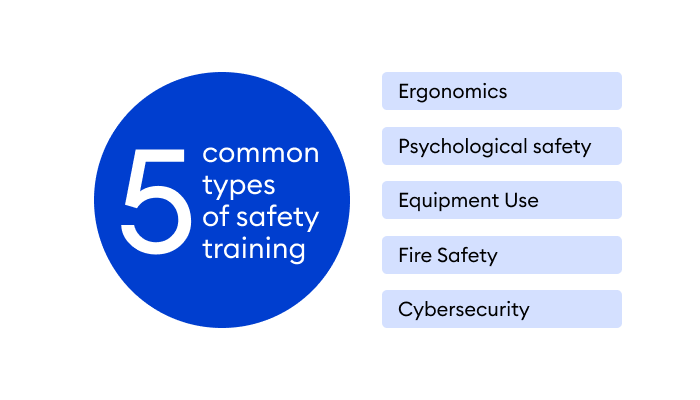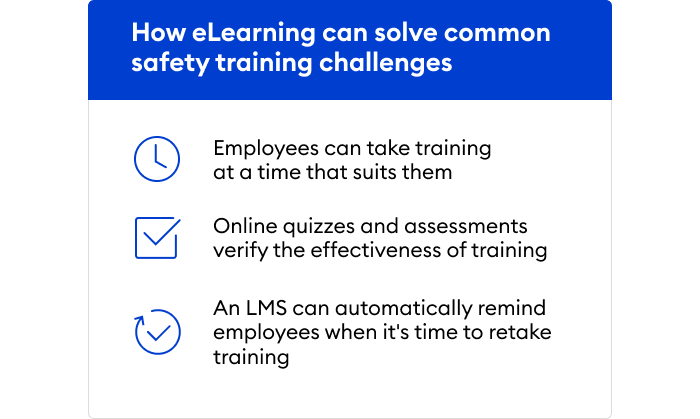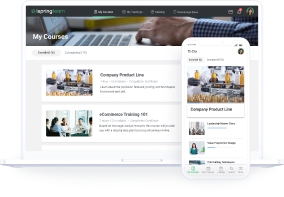Employee Safety Training: How To Take It Online

Did you know that US employers spend $1 billion a week on workers’ compensation? Workplace health and safety training not only saves employees from serious injuries or even death, but it saves companies billions of dollars every year in payouts and loss of profits.
In this guide, we touch on the different types of safety training, how to create an effective training program in your organization, and many other important things concerning this topic.
What Is Employee Safety Training?
According to Wikipedia, employee safety training is an unofficial phrase used to describe the learning content created to teach occupational safety and health standards developed by the United States government labor organization, Occupational Safety and Health Administration (OSHA).
In a broader sense, workplace safety training is the learning material designed to provide staff with the key knowledge and skills they need to carry out their jobs safely. The goal is to ensure that every worker has the essential expertise to keep themselves and their colleagues safe at work.
Safety training also teaches employees on the company’s procedures and policies to identify hazards and risks in the workplace. Furthermore, it provides guidelines on how to report safety incidents.
Types of Safety Training
Safety training is typically included as part of an onboarding program to outline important health and safety procedures that all workers must follow. Besides, it is often used as refresher training to help employees reinforce their knowledge. It is especially common in the construction, agriculture, hazard waste, and emergency response fields, where it’s required to retrain annually.
When it comes to employee safety training topics, there really is no “one size fits all”. For instance, a law firm will require very different training than a warehouse or supermarket. Still, let’s take a look at the most common topics.

Training on ergonomics in the workplace
A third of workplace accidents are categorized as ergonomic. That’s why ergonomics training is essential, especially for office work environments, industrial work environments such as factories and plants, and the transportation industry where workers spend long hours behind the wheel. It teaches workers how to position themselves correctly when sitting and how to move heavy objects without causing themselves injury.
Cybersecurity training
43% of cybersecurity attacks are aimed at SMBs, that’s why it’s crucial to train employees on data protection regulations, the safe handling of information, and how to spot cyber threats such as phishing and malware.
Fire safety training
Fire safety training should cover the steps to take in the event of a fire, how to use fire extinguishers, and the location of fire exits. In some cases, employers may train their staff on additional precautions, such as fire-proofing the office.
Training on safe use of equipment
It covers the correct use of job-specific equipment, such as personal protective equipment (PPE). Depending on the industry, it can also include the safe use and storage of machines, protective clothing, or moving vehicles.
Psychological safety training
As an increasing amount of focus is put on the importance of emotional well-being, psychological safety training is becoming more common in the workplace. It addresses how to create and maintain a work culture where employees feel safe to share ideas, speak up, and be themselves and may also cover mental health issues such as stress management techniques, and mindfulness activities to promote emotional wellbeing.
Also read: How to Build a Learning Culture
Common Challenges to Safety Training and How to Address Them with eLearning
Safety training can be life or death, yet 17% of small business employees never receive it. So, what are the biggest challenges organizations face when it comes to safety training? According to research by Workplace Safety Academy:
- 59.1% of organizations cite scheduling time
- 31.1% say verifying the effectiveness of the training
- 23.7% attribute arranging refresher training. Fortunately, eLearning can help overcome all of them.
eLearning provides a flexible training solution that employees can undertake at a time and place that suits them. In addition to it, when using a learning management system (LMS), they can automate training management tasks such as reminding employees when it’s time to retrain. Finally, online quizzes and assessments offer L&D teams valuable data to measure the effectiveness of the training.

Here’s a look at one business that was able to streamline its employee safety and compliance training and achieve great results by moving training online:

Forever Living is the world’s largest grower, producer, and distributor of aloe vera. Its regional distribution center, Forever Direct is responsible for distributing its products to over 90 countries across Europe, the Middle East, and Africa.
With such a dispersed workforce operating across facilities in multiple locations, health and safety training is a top priority for the organization. Previously, it conducted its safety training in person but found it to be inconsistent, ineffective and not engaging.
Since moving training online, Forever Direct has rolled out safety courses to 350 employees and external suppliers in a short time. As a result, it has seen a 50% decrease in the number of accidents in its warehouse.
How to Create Effective Workplace Safety Training Programs
We’ve outlined the 5 key steps your business should take to run an effective employee safety training program online.
Step 1. Choose a training format
Safety training can be delivered using three different learning methods: via in-person training sessions, with online courses, and as a blended learning solution. There are the pros and cons for each modality below.
In-person training
Conventional employee safety training was typically carried out in-person. Employees were required to miss work and sit through long instructor-led sessions. Despite being a familiar training model, many organizations have moved away from this training approach in recent years for a number of reasons.
| Pros | Cons |
| Familiar: Employees are comfortable with this type of training approach | Lack of flexibility: There are often scheduling restrictions, particularly in multinational businesses |
| Engaging: With the right instructor, in-person training can be enjoyable for learners | High costs: Travel, venue, and instructor expenses make this an expensive training approach |
| Retraining is tough to organize: It’s tricky for employees who miss the training session to catch up | |
| Hard to measure: There’s no way of knowing how much employees are taking in |
Online courseses
Learning, usually comprised of online courses, offers organizations a fully flexible training approach. Employees can access courses on any device and at a time they want to. In turn, they are more likely to take training. While there is an initial investment in eLearning tools, digital safety training is a cost-effective way to roll out training to workers.
| Pros | Cons |
| Flexible: Anytime, anywhere training | Adapting to change: It can take some employees time to adapt to a new training |
| Cost-effective: No travel or instructor expenses | Initial investment needed: Organizations must invest in eLearning tools to move training online |
| Time-saving: Training management tasks can be automated to reduce L&D teams’ workload | |
| Better engagement: eLearning touches on different learning styles | |
| High knowledge transfer: Staff can access training when needed | |
| Measurable: LMS reports provide detailed data on training activities |
Blended learning
Blended learning combines instructor-led training with online learning activities. Rather than replacing in-person training, online activities reinforce the learning. This training approach is a popular option for businesses that want to gradually introduce a digital training model. Employees can get accustomed to online learning with the added security of knowing there is an instructor on hand if needed.
| Pros | Cons |
| Engaging: Employees can benefit from different learning styles | Costly: Organizations still incur training costs such as travel and instructor expenses |
| Better knowledge transfer: Workers can refresh their memories using the online resources | Time consuming: Blended training models require a lot of organization and scheduling |
| Measurable: LMS reports provide detailed data on online training activities | Lack of flexibility: Staff must attend scheduled training sessions |
Recap: In recent years, there has been a huge shift in how workplace safety training is delivered. Most businesses now favor eLearning for training safety due to the flexibility and tracking benefits.
When choosing the best training approach, always consider the type of safety training you are delivering. For example, a blended training program may work best when training on the safe use of machinery. It could blend online tutorials with an in-person demonstration for optimal training results. By contrast, it makes sense for cybersecurity training to be carried out through online courses only.
Step 2. Assemble a training program
At this stage, we recommend that you zoom out and look at the big picture. There’s time to get into the nitty-gritty details later in the planning process. For now, create a birds-eye view of the topics you want to cover and how they will fit together.
Here’s a quick walkthrough on how to create a safety training program for employees:
- Review existing safety training materials
- Consult with SMEs in the company to come up with a list of safety training topics
- Ensure your training meets all industry and national regulations
- Outline the topics to cover in the training program
- Come up with an activity to practice each topic
For clarity, check out an example outline of a data protection training program:
| Learning Topic | eLearning Training Solution |
| Data protection rules and regulations | Video lecture: Overview of CCPA guidelines |
| Data breaches case studies | Flashcards: Summarizing each data breach case study (audio narration available) |
| Handling customer data | Role-play: Safely taking customer data over the phone Interactive image-based activity: Click the data on the credit card that you should take down on the call |
| Reporting a data breach | Screencast: How to log an incident in the employee portal Interactive sorting activity: Match the type of incident with the correct incident issue code |
| Recap | Interactive assessment: Review the key points covered in the training Additional reading: Downloadable PDFs with extra resources on safety policies Certificate of course completion: Evidence that all safety training courses have been successfully completed |
Step 3. Prepare training content
To create content or to buy off the shelf, that is the question?
Many organizations face this decision when coming up with workplace safety training. On the one hand, buying a pre-made course can save businesses time. On the other hand, the topics covered in this course are not tailored to the organization. This can be an issue as learners tend to switch off when training isn’t relevant to them and their job. Furthermore, buying off-the-shelf safety training courses can be costly and your business has no way to customize or update the content.
If your organization has made the decision to create its own health and safety training content, now is the time to begin doing this. Getting started may seem daunting, but all you need is a content authoring toolkit. This will allow you to build online courses with interactive activities, videos, and quizzes.
With iSpring Suite, you can design compelling online courses for any safety training scenario. As a PowerPoint-based tool, it is simple to use, empowering your team to create engaging courses in minutes. Complete with tried-and-tested slide templates, a full character library, 14 different interactions, and 14 types of interactive question templates, courses can be customized to suit your business and learning goals.
iSpring Suite
Fully-stocked eLearning authoring toolkit for PowerPoint. No training required to start!
To give you some safety training ideas, we’ve put together a few examples of content on safety topics you can make using iSpring.
Online courses
eLearning courses are one of the most effective ways to train safety in the workplace. By combining a variety of interactive activities, they touch on multiple learning styles. In turn, this boosts retention and increases the effectiveness of the training.
This captivating fire safety course made using iSpring Suite is a perfect example of how to make safety training engaging and relevant. Learners are compelled to participate in the training, clicking on workplace hazards, putting out fires, and putting evacuation steps in order. Images, such as the evacuation plan, provide visual aids to improve learning and support key messages.
Role-plays
Role-plays replicate real-life scenarios that arise in the workplace. In doing so, they empower employees to develop the skills and behaviors needed to effectively deal with common issues in their job. For example, role-plays scenarios can be used to practice dealing with an angry customer. Feedback is given throughout the role-play to ensure the employee knows the desired behavior.
Most typically leveraged to train on soft skills, these real-life simulations can be adapted for use in security courses. For example, you can prepare a role-play to help staff learn how to correctly (and safely) collect customer data over the phone. It gives employees a chance to practice and master scripts in a safe environment without the risk of potential data breaches or slip-ups. As a result, workers gain confidence in handling customer data in a risk-free setting.

A slide from the course on how to safely collect customer data over the phone created with iSpring Suite
Video courses
Video training can be made up of three different types of recording:
- Talking-head videos — Record an instructor or subject matter expert talking directly into the camera and explaining workplace safety rules, regulations, and policies.
- Screencasts — Create software tutorials, for example showing employees how to log safety incidents.
- Picture-in-picture videos — Show your screen and webcam video simultaneously to highlight safety hazards and risks or point out safety features in a virtual office tour.
Video tutorials are a highly visual and engaging way to train on employee safety. What’s more, they are a multi-use training tool. For instance, videos can be used as stand-alone learning content or added to other employee safety courses.
How To Deliver Safety Training to Employees
Once you have created (or bought) your first eLearning course and tested it out, you’ll need to deliver it to employees. That’s where a corporate LMS comes in.
If you don’t have an LMS yet, try iSpring LMS. You will have all training in one place, giving your employees freedom of taking courses whenever and wherever they want to.
iSpring LMS will let you manage all training tasks directly on the platform to cut down on manual tasks. The in-built gamification options, such as badges, point systems, and certifications, can be leveraged to incentivize your staff to complete safety training successfully.
iSpring LMS also enables teams to automate learning. Employees will receive an automated email notification when it’s time to retake the safety courses. As a result, organizations can stay on top of retraining requirements, ensuring employees undertake all necessary safety training within a certain timeframe.
How to Measure Results on Workplace Safety Training
Congratulations! You have successfully launched a workplace safety training program. However, your work isn’t over just yet. It’s now time to measure the results. As we have mentioned, a core driver behind the switch to online training is the ability to track learning data.
Using the LMS, you are able to extract detailed reports that show several success metrics. For instance, how many employees have completed the training? High completion rates suggest your communication strategy for the training was successful.
Also read: → Best Employee Training Tracking Software
Has a large number of learners stopped mid-way through the training? This could indicate the course isn’t engaging enough.
Did a large portion of staff members fail the final assessment? Poor assessment results could be a result of a poorly written quiz or a lack of clarity in the training material.
As they say, knowledge is power. LMS reporting doesn’t just allow for better bookkeeping, it enables you to analyze training and improve it over time.
Want to know more? Our detailed LMS reporting guide breaks down all the learning metrics you need to know.
Conclusion
Effective employee safety training can help your organization avoid nasty accidents, production losses, and low morale. However, many small businesses still haven’t incorporated it. To provide your employees with an accessible, flexible way to learn important safety rules and behaviors, move your training program online.
To start creating compelling safety training courses for your staff today, get a free trial of the iSpring Suite authoring toolkit. You’ll be able to test-drive its full range of features for 14 days, without paying a cent. What’s more, you can start making your organization a safer place in a matter of minutes!
Finally, if your company is looking for a user-friendly LMS with robust reporting features, get an iSpring LMS free trial today!






